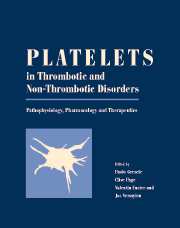Afterword: Platelets: a personal story
Published online by Cambridge University Press: 10 May 2010
Summary
Platelets were a major research interest of mine from the 1960s to the 1980s. During that period descriptive knowledge of platelets was superseded by understanding of their pathophysiological mechanisms and functions. The Editors' invitation was for a brief account of personal work, some of which turned out to be seminal, of course in its wider setting. So I hope this will be as enjoyable to read as it was to write. It has made me look again at our platelet publications of so many years ago that I had forgotten much of what we did and was pleasantly surprised by rediscovering it. The request was for a personal story. So the massive and essential contributions from large numbers of contemporary workers are set out in the historical chapter of this book. This account provides another opportunity of acknowledging the many excellent coworkers, listed below, many of whom carried on with research in various parts of the world and some of whom are contributors to this book.
In 1976 the Royal Society invited me to give a lecture to the British Association of Young Scientists. By then platelets had been my major concern for 15 years. So the title of my lecture was Why don't we Bleed to Death? The vital defence mechanism of hemostasis. The abstract, made as attractive as possible for young people, still stands as a reliable summary of what platelets are primarily about:
‘As soon as primitive metazoan animals acquired a body cavity containing a fluid different in composition from the environmental fluid they had something to defend against change, a milieu interieur to keep constant.
- Type
- Chapter
- Information
- Platelets in Thrombotic and Non-Thrombotic DisordersPathophysiology, Pharmacology and Therapeutics, pp. 1063 - 1072Publisher: Cambridge University PressPrint publication year: 2002
- 2
- Cited by



